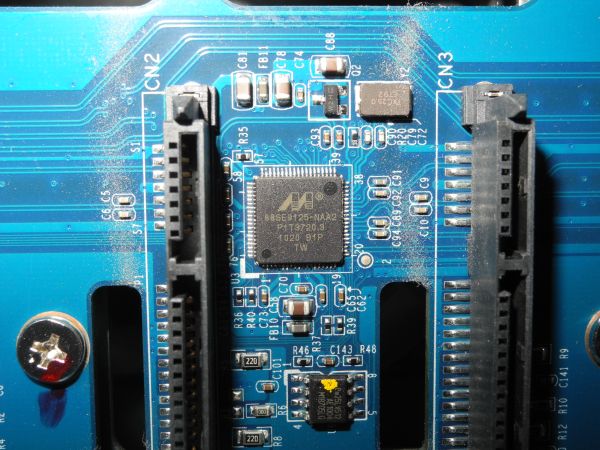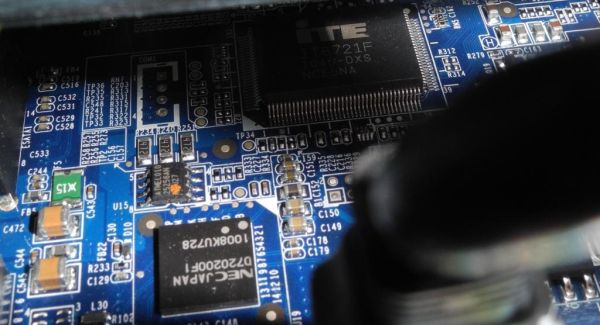QNAP TS-659 Pro II Review
by Ganesh T S on September 19, 2011 8:00 AM EST- Posted in
- IT Computing
- NAS
- QNAP
The host silicon in the SMB / SOHO NAS market is primarily from two players. While the low end is dominated by Marvell, the high end is dominated by Intel's Atom processors. As one goes higher, we have even more powerful Intel CPUs (such as the low end Core i3s). Freescale used to have some design wins till 2009 with their PPC based processors, but we haven't seen any units based on their processors in their last two years.
Removing the drive bays of the TS-659 Pro II reveals an array of 6 SATA slots and a couple of Marvell 88SE9125 chips [PDF]. These are SATA to PCI-E bridges, with support for 2 SATA devices. We believe another of these bridge chips must be present on the other side of the SATA slots array. This array connects to the PCI-E bus on the ICH9 southbridge.
Most of the high end SMB / SOHO NAS units have 1 GB of RAM which can be expanded. The TS-659 Pro II also has 1 GB of RAM expandable to 3 GB. In order to install this notebook memory, one needs to open up the unit. The brushed steel top can be removed by taking off the screws at the rear end and sliding the top out. The motherboard is covered by a screwed on plastic film with a flap above the SODIMM slot where the user can put in the additional memory.
The rest of the components are not easily accessible, but we did manage to grab a snap of the Renesas-NEC 720200 USB 3.0 to PCI-E bridge which enables the two USB 3.0 ports on the unit. The iTE IT8721F is the hardware monitor sensor and fan control chip.
In the next section, we will have the testing methodology outlined and also a description of the testbed.













69 Comments
View All Comments
bobbozzo - Tuesday, September 20, 2011 - link
So can you add more drives to the RAID using eSATA? How many?Thanks!
ganeshts - Tuesday, September 20, 2011 - link
It supports port multipliers in the sense that you can configure share folders on it. However, I don't think RAID expansion is supported: http://forum.qnap.com/viewtopic.php?p=158110 : Note that I am unable to test this out right now because the review unit is being put under stress for one of the bugs reported elsewhere in this comments section.beginner99 - Tuesday, September 20, 2011 - link
IMHO only makes sense for business use. Only advantage to a DIY build is the small case with hot-swap. Have not seen such a case anywhere for a DIY build.But besides the case size you can get better hardware for half the price with DIY.
I'm quite astonished by the 72 watt. Do hdd's need that much power?
jmelgaard - Tuesday, September 20, 2011 - link
I Disagree that the only advantage is the small case, a DIY solution might not even be possible for some consumers as they simply won't know "how to" build your own, these boxes has a high level of convenience to them and putting together components to hit the same low power consumption could be a picky task.But ofc. it's your opinion so I can't but say mine is different.
The drives is rated at 7.4 Watts typical under read/write according to specs the Processor is according to Intel rated around 13 Watts.. that sums to 57,4 Watts... Add the rest of the components and I think it sounds fairly realistic...
DanNeely - Tuesday, September 20, 2011 - link
Most of the remainder is probably PSU inefficiency. Assuming 80% efficiency you get 71W of power in for the components you listed.asakharov - Tuesday, September 20, 2011 - link
Not long ago I had a chance to test I/O performance of QNAP TS-459 Pro II (the same generation as at article) and older TS-439 Pro II. Looks like not my, not TS-659 Pro II could really use Ethernet load balancing - no I/O performance change according to NASPT. All available Ethernet teaming type was tested. All disks are in RAID0The best I/O performance I received with one Ethernet connected to NAS.
The simplest is the fastest?
meesterlars - Tuesday, September 20, 2011 - link
I would urge you, Anand, to consider making readers of your site aware of an undisclosed but critical bug affecting QNAPs with newer firmware versions; it seems a certain combination of free space and number of files stored on the NAS can cause anything from appalling performance to data corruption and eventually data loss.The following link documents the failure of a 10TB storage node.
http://forum.qnap.com/viewtopic.php?f=189&t=46...
According to their forums, QNAP are investigating...
It seems we too might be showing symptoms of this bug at one of our customer's installations where we had two freezes last week alone, requiring customer interaction (i.e., "pull power, please"). Not ideal.
rancid-lemon - Tuesday, September 20, 2011 - link
Ouch, I've just read through this thread and seems to be a show stopper.I was looking at buying a QNAP device but this may have to go on hold.
There does seem to be some qnap support on the subject but that haven't revealed any details of a fix, time frame to solution or anything. Plus they seem to be no closer to a solution (or indeed know generally what is going on with their own system!)
Thanks for the heads up!
ganeshts - Tuesday, September 20, 2011 - link
Thanks for posting this. I am trying to recreate the issue in the unit we have, and if I am successful in doing it, I will post an addendum to the review.rancid-lemon - Tuesday, September 20, 2011 - link
Just so you are aware, having read the entire thread it seems to affect larger hard drives, 2TB+. I notice that your review system was using 1TB drives.The issue may still occur with 1TB drives though since according to that thread there seems to be an amount of uncertainty involved as to the cause.